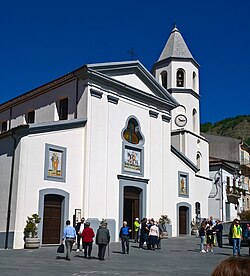San Costantino Albanese
You can help expand this article with text translated from the corresponding article in Italian. (January 2022) Click [show] for important translation instructions.
|
San Costantino Albanese | |
|---|---|
| Comune di San Costantino Albanese Bashkia Shën Kostandinit i Arbëreshëvet | |
 Church of San Costantino il Grande. | |
St. Constantine the Great | |
| Saint day | 21 May |
San Costantino Albanese (
Geography
San Costantino Albanese sits on a hilltop overlooking the Sarmento Valley and is located across the valley from San Paolo Albanese. The Sarmento River is a dry rock-strewn riverbed during the summer but can be a torrent during the winter rains. The two towns are 3 kilometres (2 mi) apart but the path through the river valley by road is about 8 kilometres (5 mi).[4]
The village is bordered by the towns of Alessandria del Carretto, Cersosimo, Noepoli, San Paolo Albanese and Terranova di Pollino.
It is also adjacent to Pollino National Park.
History
San Costantino Albanese was founded in approximately 1534 by ethnic Albanians refugees or Arbëreshë, from Corone, Morea in Greece which was occupied by the Ottoman Turks. Surnames such as Scutari, reflect this connection with the Albanian heritage.
In the early 20th century, the town, like much of
Frazioni
Venticalia
Venticalia is a village located approximately 3.9 kilometres (2.4 mi) from San Costantino.
Since the end of the 17th century, it has been the
Today the village is the site of a compressed wood pellet factory.
Martorino
Martorino is one of the concessions granted by the Pignatelli feudal family in the late 17th century to the Pace family.
Local businesses include agriculture and agritourism.
Notable people from San Costantino Albanese
- Liborio Liguori (born 1950), football player.
References
- ^ "Superficie di Comuni Province e Regioni italiane al 9 ottobre 2011". Italian National Institute of Statistics. Retrieved 16 March 2019.
- Istat)
- ISBN 9788824020091.
- ^ The Italo-Albanian Villages of Southern Italy, George Nicholas Nasse

